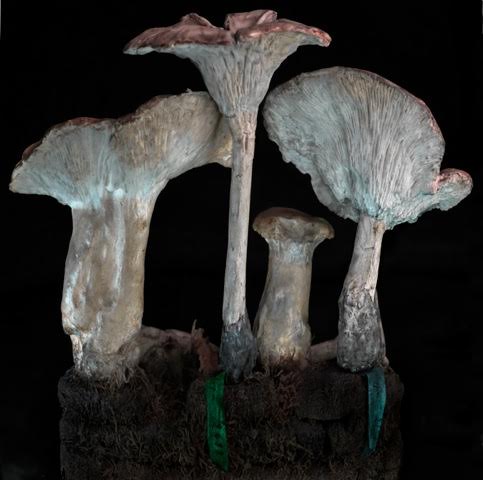
Parlour, in association with Starkwhite, is thrilled to host Phantasma 2011, an exhibition by esteemed artist Dr. Fiona Pardington (Ngāi Tahu, Kāti Mamoe and Ngāti Kahungunu), Chevalier de l’Ordre Française des Arts et des Lettres.
The Muséum de l’Histoire Naturelle in Nice, driven by the celebrated naturalist, Antoine Risso (1777-1845), was the first museum to open its doors in that city, in the Place Saint François (the old city square) in 1846. Jean-Baptiste Vérany (1800-1865) compiled its rich collections of birds, molluscs, minerals and fossils, but of interest to us is the private collection plaster and wax models of fish, flowering plants, and especially fungi of the South of France by Jean-Baptiste Barla (1817-1896). Barla’s collection became part of the museum in 1863 when it moved to its own premises on the site of the current museum, donated to the City of Nice in 1896. It was here on a visit to Nice in April 2011 that Pardington discovered the mycological collection and photographed it for four fungus-filled days.
It is only natural that a culinary culture like the French would be fascinated by fungi. The playwright and satirist Molière named his most famous fictional creation Tartuffe for the old French for truffle, and even named his country estate “Perigord” for the region in France where the black truffle grows. The French invented the cultivation of mushrooms, growing them in the limestone caves at Bourré in the Loirre Valley since the reign of Louis XIV. Every regional cuisine of France uses its own locally growing fungi: truffles, champignon de Paris, channterelle, pleurote (oyster mushrooms), and cèpes (porcini). If you can eat it, the French probably have a sauce that goes with it, and consequently the French know their fungi. The Larousse Gastronomique contains extensive notes on the cooking of mushrooms, and the poisonous ones to avoid. Models like the Barla collection were originally created and circulated around the French municipalities on the typically pragmatic orders of a recently restored Napoleon III so that the public might be educated about which mushrooms were and were not safe to eat. As Pardington notes —
“What I love about the Barla polychromed champignons is that these fairy-towers or toad-perches aggravate the incorporeal freedom that the simple materiality of the photograph gestures towards. This freedom imbued in every photographic act positively charges us with its link to the invisible realms of metaphysical thought as equally of any intellectual or scientific ruminations. The photograph always impresses us with its blithe ability to preserve and transmit an intimate physical knowledge of our visible world, although its existence does not necessarily depend on any of the references it springs from. For instance, if I take my photographic portrait, it is not necessarily a correlate of my thought, nor a necessary correlate to my absence, or by any absence of knowledge about any of its situated-ness. Photographs operate anonymously perfectly well, and pouring through the thousands of carte-de-visites at the Vanves fleamarket recently impressed this upon me yet again. When my eyes fall upon the photograph of any of the mushrooms, I imagine Barla’s spade plunging in to the earth, editing out the fairy ring of Russula furcata, activating a kind of transubstantiation where the very this-ness of that day, the haecceity of that day and that hour of September 1862 remains with us thanks to the two styles of time portal that moulage and photography represent to us.”
Over the years, however, the pigments on the models have changes so that they are no longer scientifically accurate; spectacularly so in the case of the R. emetica. This factor contributes another layer of distance and complexity to what at first glance might be considered a relatively simple body of work. As the artist herself says: “For me it is a very nice undercutting of the scientific drive for arrangement of detailed knowledge and certainty. It adds a further ‘danger’ too, because if you followed the advice of these wee plaster and paint confections you could end up dead.
— Andrew Paul Wood


